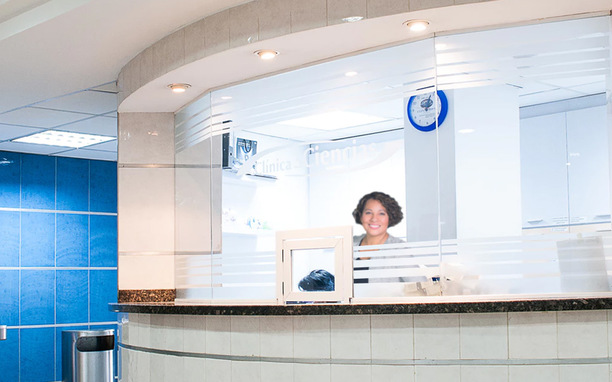This week, we take a look at five deadly sins that can kill the patient experience.
 1. Ignored at the Reception Desk
1. Ignored at the Reception Desk
The receptionist’s desk is likely the first point of person-to-person contact your patients have with your organization. The receptionist’s greeting, or lack of, can kill the entire patient experience before it ever gets started. The difference between a warm, welcoming smile, and being ignored is huge.
A study published in the British Journal of General Practice found the helpfulness of receptionists ranked right up there with communication with the doctor as key drivers of patient satisfaction.
The first impression made by the receptionist sets the tone for the entire the patient experience.
As part of their M3 survey questionnaire, most of our M3-Patient Experience® clients use one of the two following questions to measure the patient’s perception of their Receptionist experience.
How often are the clerks and receptionists at this provider’s office as helpful as you thought they should be?
– Always
– Usually
– Sometimes
– Never
When I checked in, the receptionist was courteous and friendly. (select one)
– Strongly Agree
– Agree
– Neutral (neither agree or disagree)
– Disagree
– Strongly Disagree
If your practice currently subscribes to M3-Patient Experience, to review how your practice is doing relative to Receptionist Helpful or Receptionist Courteous, simply login to M3 and click “Reporting” and then click “Percentiles” from the analytics menu on the left. When the “Percentiles’ page loads up, select the Receptionist question from the drop-down menu.
 2. A Waiting Room that Feels Like a Waiting Room
2. A Waiting Room that Feels Like a Waiting Room
Since we’re on the topic of first impressions, we can’t forget the waiting room.
A comfortable waiting room is essential. Simple things such as comfortable lighting and having enough chairs and space to accommodate the patient load are not always at the forefront of an administrator’s mind, but crucial nevertheless. Outdated and messy magazines can leave the impression that patient comfort is an afterthought. An investment in modernizing the waiting area such as digital signage, tablets, and televisions are a powerful way to ensure your waiting room meets the expectations of a modern patient.
Refreshments are becoming the norm and many patients expect bottled water, coffee, and perhaps hot tea.
Transforming the waiting room into a welcoming reception area, ensuring patients are as comfortable as possible is the key.
Patients that are made to feel welcomed and kept informed about their wait time have a more favorable perception of their entire experience, including the clinical aspects of their visit. To learn more, feel free to revisit our blog titled, “PATIENT COURTESY AND WAITING ROOM ROUNDING FOSTERS FIVE-STAR CUSTOMER SERVICE.”
 3. Heads Buried in a Screen
3. Heads Buried in a Screen
From the receptionist at the check-in counter to the in-take nurse to the physician and to the checkout clerk, it seems EVERYBODY is connected to an electronic device with a screen. Learning to make eye contact with the patient while concurrently navigating our world of electronics is a must. When heads are buried in a screen, patients feel neglected and put-off.
There are 10 Standards of Behavior and customer service techniques that every healthcare organization (indeed every business) will find critical as the organization seeks to create and sustain a culture of service excellence. The importance of making eye contact is number one on the list.
 4. Unhappy Employees
4. Unhappy Employees
Highly satisfied patients start with highly satisfied employees. The converse is also true. Unhappy employees lead to unhappy patients.
Healthcare is, after all, a business based on building and nurturing relationships with others. People quickly pick up on the moods and emotions of other people and we are often impacted by the moods and demeanor of others. One of the most important steps every healthcare facility can take towards improving patient experience lies in prioritizing the well-being of their employees. Moving past employee satisfaction to employee engagement works.
 5. Inaccurate and Confusing Billing
5. Inaccurate and Confusing Billing
Billing so often gets forgotten, and it can be an enormous point of conflict for patients. Many healthcare administrators have long since outsourced billing to a third party or segregated the process so that it does not adversely impact the daily operations of running the practice. Like it or not, billing is still part of the process and if left unattended, can leave your patients with a very sour taste.
Many patients feel overwhelmed by the financial burden of their medical services. Recent headlines include Surprise Medical Billing and how it impacts your patients. In the American Journal of Managed Care article titled, “5 Things About Surprise Medical Billing” by Jamie Rosenberg, we learn that in spite of everything that is being done to help curtail Surprise Medical Billing, the prevalence continues to rise.
Having your staff communicate patient financial obligations up front, as well as incorporating a process of clear billing can do wonders in closing out an all-around positive and satisfying experience for your patient. Educating and setting patient expectations helps to minimize the ‘surprise factor’.
Please let us know if you have comments or questions, and subscribe to our Email Updates, so that you can be assured to receive Thinking Thursdays TIPs.
Thank you!
Jerry
Jerry L. Stone
Co-Founder/COO
MedicalGPS, LLC.
Resources:
1) Compassionomics: The Revolutionary Scientific Evidence That Caring Makes a Difference, by Stephen Trzeciak and Anthony Mazzarelli.
2) Stanford University’s Center for Compassion and Altruism Research and Education stated, the article titled, “Compassion and kindness produce better outcomes. The healing touch“, by Graziella Steele
3 )The Importance of Physician-Patient Relationships Communication and Trust in Health Care, by Tyler Johnson
4) Psychology Today, “7 Ways to Build Trust in a Relationship”, by Andrea Bonior Ph.D.
5) Citation: Birkhäuer J, Gaab J, Kossowsky J, Hasler S, Krummenacher P, Werner C, et al. (2017) Trust in the health care professional and health outcome: A meta-analysis. PLoS ONE 12(2): e0170988. https://doi.org/10.1371/journal.pone.0170988

